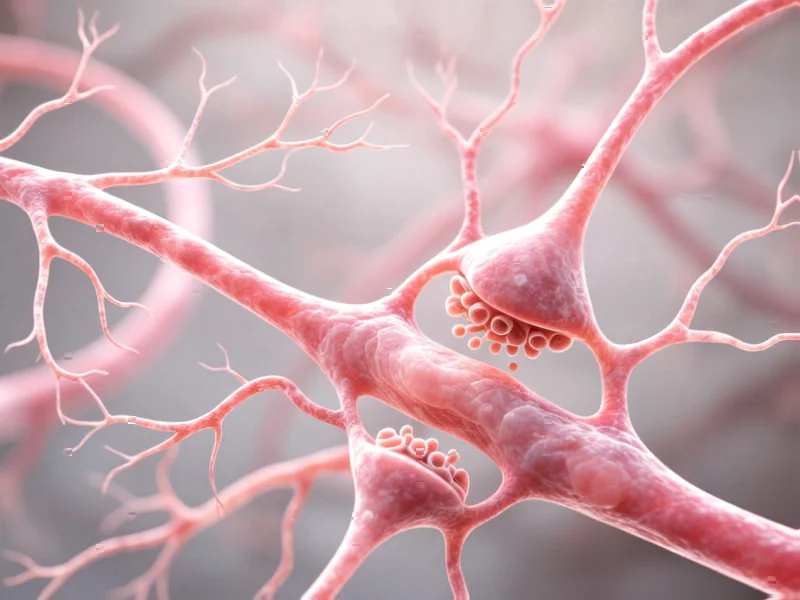According to science.org, researchers have successfully rewired neural circuits in fruit flies by manipulating a combinatorial code of cell surface proteins. The team genetically reprogrammed olfactory receptor neurons (ORNs) that normally target the DA1 glomerulus to instead connect with projection neurons (PNs) from the VA1v glomerulus using just five key proteins. This required engineering flies with 11 transgenes and applying three strategic manipulations: increasing repulsion from original partners, decreasing repulsion from new targets, and matching attraction to new partners. The anatomical rewiring translated to functional changes, with the modified VA1v-PNs now responding to a pheromone they normally wouldn’t detect, and male flies showing increased courtship behavior toward other males. This breakthrough demonstrates that synaptic specificity can be determined by a small set of cell surface proteins acting in combination.
Table of Contents
The Combinatorial Code Breakthrough
What makes this research particularly significant is the shift from single-gene approaches to combinatorial manipulation. Traditional neuroscience has often focused on knocking out individual genes to understand their function, but this typically yields incomplete results because neural wiring relies on complex interactions between multiple proteins. The researchers’ success with a five-protein combination reveals that neural connectivity operates more like a sophisticated security system requiring multiple authentication factors rather than a simple lock-and-key mechanism. This explains why previous attempts at neural rewiring have largely failed – they were trying to pick a complex lock with just one tool rather than understanding the complete combination.
Developmental Insights and Evolutionary Implications
The discovery that critical partner selection occurs on a temporary 2D surface before neurons settle into their final 3D positions provides crucial insight into nervous system development. This staged approach represents an elegant solution to the computational challenge of wiring billions of neurons efficiently. From an evolutionary perspective, this research suggests how new neural circuits might emerge through relatively small changes in cell surface protein expression. If rewiring can be achieved with just five protein manipulations, it’s plausible that evolutionary changes in brain connectivity could occur through similar modest genetic adjustments rather than requiring complete circuit redesigns.
Technical Challenges and Limitations
While the results are groundbreaking, the approach faces significant scalability challenges. The requirement for 11 transgenes and precise manipulation of multiple proteins makes this technically demanding even in model organisms like fruit flies. In more complex mammalian brains with thousands of neuron types, the combinatorial complexity increases exponentially. Additionally, the researchers focused on the antennal lobe, a relatively structured brain region – it remains unclear whether similar principles apply to less organized neural tissues. There’s also the question of whether artificially rewired circuits can maintain long-term stability and integrate properly with downstream processing networks.
Medical and Therapeutic Potential
The ability to reprogram neural connectivity opens fascinating possibilities for understanding and potentially treating neurodevelopmental disorders. Conditions like autism spectrum disorder and schizophrenia involve altered neural circuitry, and this research provides a framework for understanding how specific molecular changes might lead to circuit-level abnormalities. However, the path to therapeutic applications is long and fraught with challenges. The precision required for successful rewiring means that off-target effects could create new problems while attempting to fix existing ones. The behavioral changes observed in the flies – increased male-male courtship – demonstrate both the power and potential risks of circuit manipulation.
Future Research Directions
This research platform enables entirely new lines of investigation. Scientists can now systematically test how specific circuit changes affect behavior, potentially creating “designer circuits” to study neural computation. The approach could be extended to study synaptic plasticity in learning and memory, or to investigate how neural circuits compensate for injury. A particularly exciting direction would be applying similar principles to regenerate damaged connections in neurological conditions. However, each step toward more complex organisms will require overcoming substantial technical hurdles related to delivering multiple genetic modifications safely and specifically to target neurons and their axons.
Ethical Considerations
As neural circuit engineering advances, it raises important ethical questions about the boundaries of biological manipulation. The ability to fundamentally alter how an organism processes sensory information and behaves represents a profound level of biological control. While current applications are limited to research models, the principles demonstrated could theoretically be applied to more complex organisms. The field will need to develop clear guidelines about appropriate applications, particularly as the technology becomes more sophisticated. The behavioral changes observed in this study serve as a reminder that circuit-level manipulations can have unexpected consequences that extend far beyond the targeted neurons.
Related Articles You May Find Interesting
- Bill Gates’ Climate Pivot Sparks Expert Backlash
- Siemens Energy Bets on T-Mobile’s 5G Network Slicing for Critical Infrastructure
- Crystal Method Captures Sugar’s Secret Structures
- Earnings Season’s Most Reliable Winners Revealed
- JPMorgan’s AI Education Gamble: Banking’s $18B Bet on Workforce Transformation



